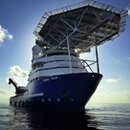iamrushman
Contributor
great reading....thanks for the info and update..
Welcome to ScubaBoard, the world's largest scuba diving community. Registration is not required to read the forums, but we encourage you to join. Joining has its benefits and enables you to participate in the discussions.
Benefits of registering include
...On a related note, some divers were killed in the mid-70s from hyperthermia. We all know about "heat of compression" from filling Scuba tanks. The same happens in chambers. Many sat complexes allow cross-connecting gauges in order to check them for accuracy and as backup in case of failure. Somebody had opened the cross-connect and the word didn't get back to the console operator (human factors sort of sucked).
The chamber that the gauge was actually connected to was unmanned and was about to be "surfaced" (pressure bled off) in order for crews to clean and repair. Bottom line, the operator heard gas blowing off, the pressure droped on the gauge he thought was to the manned chamber, and started adding Helium as fast as possible in an attempt to overcome the "leak" (standard procedure). Lots of noise, yelling topside and over the unscrambler, and not much time passed.
By the time they figured it out the manned chamber was at or below the rated working pressure (not sure if relief valves popped), at least two guys were dead (don't recall exactly). As I understood it, they didn't know how hot it actually got. A byproduct of living in Helium's high thermal conductivity is shirt sleeve comfortable at say 600' is about 90° F° +/- about 1°. 93° is far more sweltering than the hottest day in Houston and teeth chatter at 88°.
I had dinner with some of the diver's onboard about a month later. Pretty sad...
I recently had both his bell partners in sat ..scary stuff ...you know your having a bad day when something like that happensAkimbo;6942452 There is a fascinating thread on a sat diver whos umbilical was severed and these factors actually saved his life: [URL:http://www.scubaboard.com/forums/accidents-incidents/434720-umbilical-severed-80-meters-north-sea.html[/URL]
... But I would love to give it a try just to see the marine life at 1000-1500 foot depth...
Thanks for a very interesting parcel of information. I doubt that I will ever have the opportunity to do saturation diving. But I would love to give it a try just to see the marine life at 1000-1500 foot depth. And yes I know at that depth it is dark. But that is what big lights are for.
---------- Post added November 10th, 2013 at 07:53 AM ----------
I checked with some diving schools but they were honest and told me that I was to old. I give them credit for being honest instead of just wanting to take my money and then finding out that no one would hire me and I would be stuck with a 35K+ education bill to pay without a career.
… I was on projects in the 1970s where the operating cost were $2 Million/day and progress was largely measured by how much a single diver accomplished...
… Akimbo, thanks for bringing back memories!
BTW, I got into recreational training after commercial work. I developed what I referred to as an "HPNS" test for new hires that would be filling dive bottles. We needed to know how they would react to a ruptured burst disc. I would replace the disc in a 3000 psi bottles valve with an 1800 psi bottles burst disc and let them fill the bottle.
I just thought of a gas planning "trick" saturation divers can get away with and illustrates some diving physics to those who never had any reason to think about it. Remember the usable gas calculation? Pressure in tank minus bottom pressure minus first stage IP
We get to cheat on bailout bottles. There is a charging whip in the transfer chamber the bell mates to. We top our bailouts off when we reach holding or saturation depth so it is the max pressure the cylinder allows as read at depth, or over bottom pressure. The tank sees the same differential pressure as it would on the surface, but can hold 445 PSI more surface equivalent gauge pressure at 1000', for example.
Sure some teams have forgotten to bleed the pressure down before decompression. Yep, the blow-out disks pop and scare the crap out of everyone. Nothing like loud and unexpected rushing gas noises to put divers in chambers on high alert instantly.

